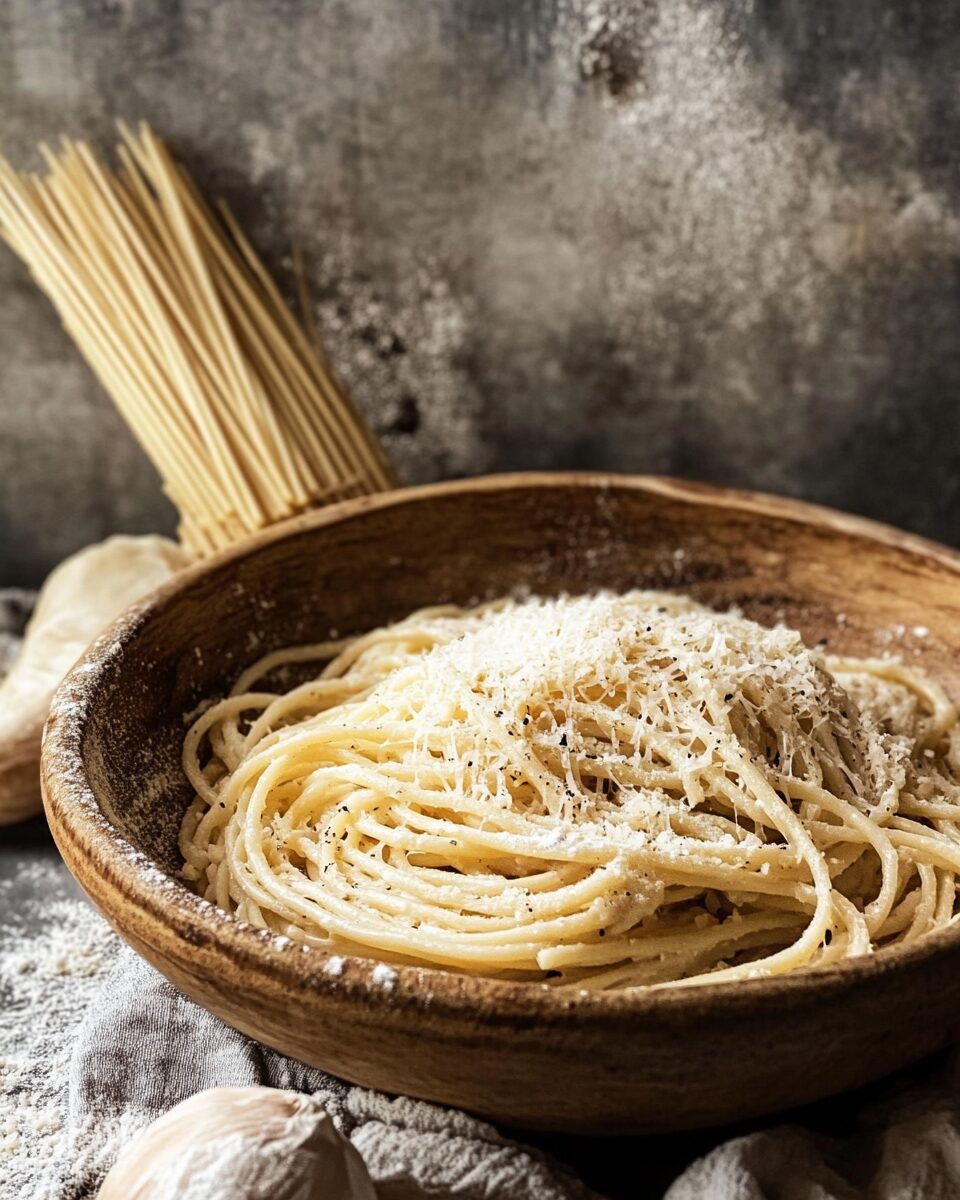Cacio e Pepe is a classic Italian pasta dish celebrated for its simplicity and bold flavors. Originating from Rome, this dish combines just a few ingredients to create a creamy, peppery sauce that perfectly coats the pasta. The name “Cacio e Pepe” translates to “cheese and pepper,” highlighting the two star ingredients that make this dish a timeless favorite.
Full Recipe:
Ingredients
-
6 ounces spaghetti or pasta of your choice
-
1 teaspoon coarsely ground black pepper, plus more for serving
-
1½ cups finely grated Parmesan cheese (or Pecorino Romano)
-
1 teaspoon salt
Directions
-
Bring a large pot of water to a boil over high heat. Add a generous amount of salt to the water and cook the spaghetti, stirring occasionally, until it’s about two minutes shy of being fully tender. Before draining, reserve 1 cup of the pasta water.
-
In a bowl, mix half of the reserved pasta water with the grated Parmesan cheese, stirring until smooth.
-
Heat a large skillet over medium heat and add the coarsely ground black pepper along with 2 tablespoons of water. Let it simmer briefly to release the pepper’s flavor.
-
Add the drained spaghetti to the skillet and pour in the cheese mixture. Stir vigorously for about 5 minutes, ensuring the pasta is evenly coated in the sauce. If the mixture seems too thick, add more reserved pasta water, a little at a time, until the sauce reaches your desired consistency.
-
Serve immediately, topped with an extra sprinkle of black pepper if desired.
Nutritional Facts
Per serving:
-
Calories: 306 kcal
-
Carbohydrates: 40g
-
Protein: 18g
-
Fat: 9g
-
Saturated Fat: 5g
-
Cholesterol: 25mg
-
Sodium: 700mg
-
Fiber: 2g
-
Sugar: 2g
The Origins and History of Cacio e Pepe
Cacio e Pepe is a traditional pasta dish that has been enjoyed by Romans for centuries. Its origins trace back to ancient times, when it was a simple meal for shepherds. The dish was born out of necessity, crafted from ingredients that were easy to transport and store, such as pasta, pecorino cheese, and black pepper. The shepherds who roamed the Lazio region, which includes Rome, would carry these basic staples with them as they moved from place to place, making Cacio e Pepe an ideal choice for sustenance.
In Roman times, the cheese used in Cacio e Pepe was usually Pecorino Romano, a sharp, salty sheep’s milk cheese that has been produced in the Lazio region for over 2,000 years. Pecorino’s strong flavor made it an excellent complement to the pepper, which added spice and depth to the dish. The simplicity of the recipe meant that it could be quickly prepared with minimal equipment, making it perfect for those with limited resources.
The Appeal of Simplicity in Cacio e Pepe
One of the reasons Cacio e Pepe has remained so popular for centuries is its simplicity. In a world where complex, multi-ingredient dishes are often the norm, Cacio e Pepe stands out for its minimalism. The beauty of the dish lies in the balance of just three main ingredients: pasta, cheese, and pepper. When prepared correctly, these few elements come together to create a rich, creamy sauce that perfectly coats the pasta.
The simplicity of Cacio e Pepe also speaks to the philosophy behind much of Italian cooking – that good food doesn’t need to be complicated. The quality of the ingredients is what makes a dish exceptional. In the case of Cacio e Pepe, the type of cheese used, the freshness of the black pepper, and the perfect amount of pasta water to achieve the sauce’s creamy texture are all key factors that make the dish shine.
Moreover, this recipe doesn’t require elaborate kitchen equipment. All you need is a pot to cook the pasta and a skillet to combine the ingredients, making it an accessible dish for home cooks of all skill levels. This ease of preparation combined with the bold flavors has led Cacio e Pepe to become a beloved choice for both weeknight dinners and special occasions.
Cacio e Pepe Variations and Modern Twists
While the classic version of Cacio e Pepe relies on just pasta, Pecorino Romano, and black pepper, there are several ways to put a personal spin on this dish. Though purists may argue that these variations stray too far from the original, modern interpretations of Cacio e Pepe reflect how versatile and adaptable the dish can be.
Different Cheeses
While Pecorino Romano is the traditional cheese used in Cacio e Pepe, some variations may include Parmesan cheese or a mix of both Pecorino and Parmesan. Parmesan adds a nuttier, milder flavor, while Pecorino offers more tang and saltiness. The blend of the two cheeses can create a unique flavor profile, making the dish more approachable for those who find Pecorino too sharp.
Some people also experiment with other types of cheese, such as Grana Padano or even a combination of soft cheeses like ricotta and mascarpone, to add a creamier texture. These variations are often found outside of Rome but can still maintain the essence of the dish while offering a fresh take on it.
Adding Protein
For those looking to turn Cacio e Pepe into a more substantial meal, adding protein can be an option. While this strays from the original, many people enjoy adding crispy pancetta, guanciale, or bacon to the dish. These ingredients bring an added layer of richness and flavor that pairs well with the creaminess of the cheese and the heat from the black pepper.
Additionally, grilled chicken or sautéed shrimp can be added for those who want to include more protein, though these are not traditionally part of the dish.
Vegetarian and Vegan Adaptations
For vegetarians, Cacio e Pepe is already a fantastic option. However, vegans may want to enjoy a dairy-free version of the dish. Substituting the cheese with plant-based cheeses or nutritional yeast can provide a similar flavor profile without the use of animal products. Although the texture may differ, these substitutions can offer a satisfying vegan alternative to the classic Roman recipe.
Spices and Flavor Enhancements
In recent years, chefs and home cooks have experimented with adding extra spices and herbs to Cacio e Pepe to enhance its flavor. Some people incorporate red pepper flakes to add a bit of heat, while others might mix in fresh herbs like parsley or basil for a burst of color and freshness. While these additions are far from traditional, they can give the dish a new twist and appeal to those who enjoy a more complex flavor palette.
Cacio e Pepe as Comfort Food
At its core, Cacio e Pepe is a comfort food. Its warm, creamy texture and bold flavors are perfect for a cozy meal at home, making it the ideal dish for cold evenings or after a long day. The pasta’s simplicity and richness evoke a sense of nostalgia, reminding many people of family dinners or meals enjoyed with loved ones.
The dish’s comforting nature is also evident in how it has evolved to fit modern culinary trends. With its creamy sauce, peppery kick, and satisfying texture, Cacio e Pepe is a universal crowd-pleaser. Whether served to a group of friends or prepared as a solo indulgence, it’s a dish that brings comfort, satisfaction, and joy.
How to Serve Cacio e Pepe
Cacio e Pepe is often served as a standalone main course, but it can also be paired with a variety of sides. A crisp green salad with a light vinaigrette can balance the richness of the dish, providing a refreshing contrast. Roasted vegetables, such as broccoli or Brussels sprouts, complement the pasta’s bold flavors while adding a nutritious element to the meal.
If you’re looking for a more traditional Roman experience, serve your Cacio e Pepe with a glass of white wine, such as Frascati or Pinot Grigio. The acidity of the wine helps cut through the richness of the cheese, creating a harmonious pairing.
Conclusion
Cacio e Pepe is more than just a simple pasta dish – it’s a representation of the simplicity and beauty of Italian cuisine. Rooted in Roman tradition, this dish highlights the power of a few quality ingredients and the technique of transforming them into something greater than the sum of their parts. While it may be minimalistic in nature, Cacio e Pepe offers a complex, deeply satisfying experience that appeals to the senses and nourishes the soul.

